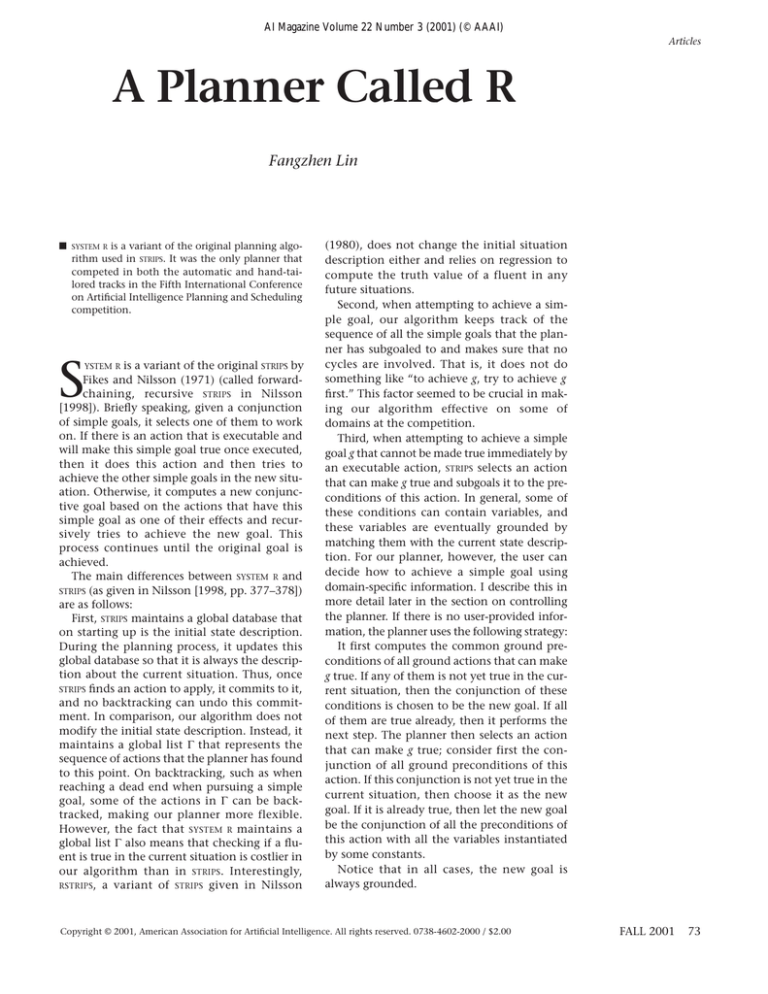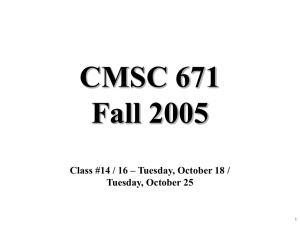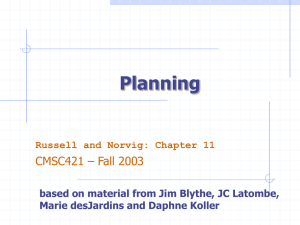
AI Magazine Volume 22 Number 3 (2001) (© AAAI)
Articles
A Planner Called R
Fangzhen Lin
■
SYSTEM R is a variant of the original planning algorithm used in STRIPS. It was the only planner that
competed in both the automatic and hand-tailored tracks in the Fifth International Conference
on Artificial Intelligence Planning and Scheduling
competition.
S
YSTEM R is a variant of the original STRIPS by
Fikes and Nilsson (1971) (called forwardchaining, recursive STRIPS in Nilsson
[1998]). Briefly speaking, given a conjunction
of simple goals, it selects one of them to work
on. If there is an action that is executable and
will make this simple goal true once executed,
then it does this action and then tries to
achieve the other simple goals in the new situation. Otherwise, it computes a new conjunctive goal based on the actions that have this
simple goal as one of their effects and recursively tries to achieve the new goal. This
process continues until the original goal is
achieved.
The main differences between SYSTEM R and
STRIPS (as given in Nilsson [1998, pp. 377–378])
are as follows:
First, STRIPS maintains a global database that
on starting up is the initial state description.
During the planning process, it updates this
global database so that it is always the description about the current situation. Thus, once
STRIPS finds an action to apply, it commits to it,
and no backtracking can undo this commitment. In comparison, our algorithm does not
modify the initial state description. Instead, it
maintains a global list Γ that represents the
sequence of actions that the planner has found
to this point. On backtracking, such as when
reaching a dead end when pursuing a simple
goal, some of the actions in Γ can be backtracked, making our planner more flexible.
However, the fact that SYSTEM R maintains a
global list Γ also means that checking if a fluent is true in the current situation is costlier in
our algorithm than in STRIPS. Interestingly,
RSTRIPS, a variant of STRIPS given in Nilsson
(1980), does not change the initial situation
description either and relies on regression to
compute the truth value of a fluent in any
future situations.
Second, when attempting to achieve a simple goal, our algorithm keeps track of the
sequence of all the simple goals that the planner has subgoaled to and makes sure that no
cycles are involved. That is, it does not do
something like “to achieve g, try to achieve g
first.” This factor seemed to be crucial in making our algorithm effective on some of
domains at the competition.
Third, when attempting to achieve a simple
goal g that cannot be made true immediately by
an executable action, STRIPS selects an action
that can make g true and subgoals it to the preconditions of this action. In general, some of
these conditions can contain variables, and
these variables are eventually grounded by
matching them with the current state description. For our planner, however, the user can
decide how to achieve a simple goal using
domain-specific information. I describe this in
more detail later in the section on controlling
the planner. If there is no user-provided information, the planner uses the following strategy:
It first computes the common ground preconditions of all ground actions that can make
g true. If any of them is not yet true in the current situation, then the conjunction of these
conditions is chosen to be the new goal. If all
of them are true already, then it performs the
next step. The planner then selects an action
that can make g true; consider first the conjunction of all ground preconditions of this
action. If this conjunction is not yet true in the
current situation, then choose it as the new
goal. If it is already true, then let the new goal
be the conjunction of all the preconditions of
this action with all the variables instantiated
by some constants.
Notice that in all cases, the new goal is
always grounded.
Copyright © 2001, American Association for Artificial Intelligence. All rights reserved. 0738-4602-2000 / $2.00
FALL 2001
73
Articles
The Blocks World
I now illustrate the planning algorithm with an
example from the blocks world. In the version
given at the Fifth International Conference on
Artificial Intelligence Planning and Scheduling
(AIPS’00) competition, there are four actions,
given below in STRIPS style:
pickup(x)
PC: handempty, clear(x), ontable(x)
D: handempty, clear(x), ontable(x)
A: holding(x)
putdown(x)
PC: holding(x)
D: holding(x)
A: handempty, clear(x), ontable(x)
stack(x,y)
PC: holding(x), clear(y)
D: holding(x), clear(y)
A: on(x,y), clear(x), handempty
unstack(x,y)
PC: handempty, on(x,y), clear(x)
D: handempty, on(x,y), clear(x)
A: holding(x), clear(y)
This algorithm is sensitive to the order of
actions. For now, we assume that the order is as
shown here, which is the same order given at
the AIPS’00 competition. Now consider the following initial state description:
on(c, b), on(b, a), ontable(a), clear(c),
handempty
and the goal clear(a). Figure 1 shows the trace
of the planning algorithm on this problem.
Begin with the top goal clear(a) in the Goal column; it first pushes to the stack Π of simple
goals at step 2 and proceeds to find a plan for
this simple goal. Because there are no common
preconditions among all the actions that can
possibly make it true, it finds the first action
that can make clear(a) true, which is putdown(a)
in the Action column, and makes the only
(ground) precondition of this action, which is
holding(a), the new goal and records it in the
Goal column. In step 4, holding(a) is pushed to
Π and becomes the current simple goal for the
planner to achieve. In step 5, the planner finds
out that among all actions that can possibly
make holding(a) true, clear(a) is the common
precondition, so it makes their conjunction the
new goal to achieve. However, then it finds out
that one of the conjuncts, clear(a), is already in
Π, so it fails the simple goal holding(a) in step 6
and goes back to step 2 to find alternative
actions for achieving clear(a), which it finds to
be stack(a, x) for some x. However, the ground
precondition for this action is holding(a) (as
indicated in the Goal column), which cannot
possibly succeed as the previous steps shows, so
it goes back to step 2 to find another alterna-
74
AI MAGAZINE
tive action for achieving clear(a), and this time
it finds unstack(x, a) for some x in step 9.
Because the common precondition of these
actions is handempty, which is already true in
the initial situation, so it begins to instantiate
x according to some preset order on the blocks,
which in our examples is [a, b, c]. Step 10
shows that x = a will not work as one of the preconditions of unstack(a, a) would require
clear(a), which is already in Π. Thus, it tries x =
b in step 12 and makes its preconditions, handempty, on(b, a), clear(b), the new goal to achieve.
Because the first two simple goals are already
true in the current state, which is the initial
state at this point, it puts clear(b) into Π. Now
the planner tries to achieve clear(b) and eventually returns the plan [unstack(c, b), putdown(c),
unstack(b, a)]. Notice that in step 26, after
clear(b) is achieved with action unstack(c, b), it
remembers that this simple goal is part of the
conjunctive goal in step 12; so, it restores this
conjunctive goal in the next step (step 27) as
the current conjunctive goal to achieve and
finds out that after this action, handempty is no
longer true, so it pushes it to Π in step 28. Step
29 returns putdown(c) as the action for achieving this simple goal because it is the first action
that is executable and will make it true once
executed.
Postprocessing
Although the planner returns a reasonable plan
in the previous example, this might not be the
case in general. For example, given the same
initial situation description and the goal on(a,
b), on(b, c), it returns the plan
[unstack(c, b), putdown (c), unstack(b, a),
putdown(b),
pickup(a), stack(a, b), unstack(a, b), putdown(a),
pickup(b),
stack(b,
c),
pickup(a),
stack(a,b)]
which is obviously not a good one. For the
AIPS’00 competition, our team implemented
the following strategy for postprocessing:
Remove all immediate cycles. If an action is followed immediately by its complement, then
remove both the actions.
Here an action B is a complement of action
A if B always restores whatever changes made
by A. For example, in the blocks world, pickup(x) and putdown(x) are complementary to
each other and so are stack(x, y) and unstack(x,
y). It is clear that this strategy is always correct
and will return a plan that is at least as good as
the original one. As it turned out, this strategy
is very effective for the blocks world. For exam-
Articles
Actions
Π (Stack of simple goals)
1.
2.
3.
clear(a)
holding(a)
holding(a), clear(a)
pickup(a) or
unstack(a,x)
6.
7.
holding(a), clear(a)
handempty, clear(a)
fail, go back to 2.
stack(a,x)
8.
clear(a)
holding(a)
fail (like 3), go back to step 2.
9.
unstack(x,a)
clear(a)
handempty
10.
unstack(a,a)
clear(a)
handempty, on(a,a),
clear(a)
11.
12.
fail, go back to step 9.
unstack(b,a)
13.
14.
putdown(b)
handempty, on(b,a),
clear(b)
clear(b), clear(a)
holding(b)
holding(b), clear(b), clear(a)
pickup(b) or
unstack(b,x)
17.
18.
clear(a)
clear(b), clear(a)
15.
16.
holding(b), clear(b), clear(a)
handempty,clear(b)
fail, go back to 13.
stack(b,x)
19.
clear(b), clear(a)
holding(b)
fail (like 16), go back to 13.
20.
unstack(x, b)
clear(b), clear(a)
handempty
21.
unstack(a, b)
clear(b), clear(a)
handempty, on(a,b),
clear(a)
22.
23.
fail, go back to 20.
unstack(b, b)
24.
25.
Γ (Plans)
clear(a)
putdown(a)
4.
5.
Goal
clear(a)
clear(b), clear(a)
handempty, on(b,b),
clear(b)
fail, go back to 20.
unstack(c, b)
clear(b), clear(a)
26.
clear(a)
27.
clear(a)
28.
handempty, clear(a)
29.
handempty, clear(a)
30.
clear(a)
31.
clear(a)
handempty, on(c,b),
clear(c)
unstack(c,b)
handempty, on(b,a),
clear(b) (from 12)
unstack(c,b)
unstack(c,b)
unstack(c,b), putdown(c)
handempty, on(b,a),
clear(b) (from 12)
unstack(c,b), putdown(c)
unstack(c,b), putdown(c),
unstack(b,a)
Figure 1. Execution Trace for the Goal clear(a).
FALL 2001 75
Articles
Problem
Time
Plan Length
20-0
9.26
72
25-0
27.46
90
30-0
67.41
104
35-0
146.63
128
40-0
286.96
146
45-0
523.09
174
Table 1. The Blocks World.
The first number in the Problem column is
the number of blocks in the problem;
times are in central processing unit seconds.
Problem
Time
Plan Length
80-0
1.52
296
100-0
2.49
368
200-0
9.73
300-0
22.71
1158
732
500-0
65.35
1962
Table 2. The Blocks World with
Control Information.
The first number in Problem column is the
number of blocks in the problem; times are
in central processing unit seconds.
ple, after postprocessing, this plan
becomes
[unstack(c, b),
unstack(b, a),
putdown(c),
stack(b, c), pickup(a), stack(a, b)]
Table 1 shows the performance of our
planner on some typical blocks world
problems at the competition.
There are some other strategies one
can use. Our team is currently experimenting with one that will maximize
the number of actions that can be executed concurrently and do them as
early as possible.
Controlling the Planner
The performance of this planner
depends on the following factors:
First is for each fluent F, the order of
the actions that can make F true. For
example, in the blocks world, when
attempting the simple goal clear(x), a
lot of backtracking can be avoided if
we order unstack(y, x) before other
76
AI MAGAZINE
actions. Second is the ordering of simple goals in a conjunctive goal, in particular, the ordering of preconditions
of actions.
Although it is easy to provide some
mechanisms for the user to control
these orderings explicitly, our team
does not do so for our planner. We
believe this level is not where the user
wants to get his/her hands on, except
that on top-level goals, the user might
have some knowledge about in what
order the goals should be achieved, in
which case, it can be done by a simple
preprocessing step, as illustrated later
for the blocks world. In general,
though, the burden should be on the
planner to come up with a good ordering by analyzing the domain at hand.
We are working on this area for the
next version of the planner.
The main mechanism that we provide the user to control the planner
with domain-specific information is a
SOLVE-A-GOAL predicate that will override the default strategy used by the
planner for trying to achieve a simple
goal. Given a simple goal g and a situation s, SOLVE-A-GOAL(g, Action, Goal, s)
means that to achieve g in s, either do
Action or (when Action = nil) try to
achieve Goal first. For example, for the
blocks world, we can write in Prolog:
To clear a block, clear the one that is
on it:
solve-a-goal(clear(X), nil,
[clear(Y)],s) :holds([on(Y,X)],s),
not holds([clear(Y)],s).
To make the hand empty, drop the
one that the robot is holding:
solve-a-goal(handempty, putdown(X), [],s) :holds([holding(X)],s).
To hold a block, clear it first (if it is
already clear, there must be an action
that is executable and can make it
true, so it would not come to this
step):
solve-a-goal(holding(X), nil,
[clear(X)],s).
These rules, together with a preprocessing step that would sort the toplevel goal according to the order:
[ontable(xn), on(xn–1, xn), …,
on(x2, x1)]
are the control strategies used by our
planner at the AIPS’00 competition.
Table 2 shows the performance of
these control rules on some typical
problems from the competition. One
can also write similar rules to control
the planner in other domains such as
the logistics domain.
Public Availability
of the System
is distributed free of charge
and without warranty at the following
web site: www.cs.ust.hk/~flin. The
Bacchus article, also in this issue, gives
an overview of the performance of all
the planners, including SYSTEM R, in the
competition. The complete data can
be obtained from the web site,
www.cs.toronto.edu/aips2000.
SYSTEM R
References
Fikes, R., and Nilsson, N. 1971. STRIPS: A
New Approach to Theorem Proving in
Problem Solving. Artificial Intelligence 2(1):
189–208.
Nilsson, N. 1980. Principles of Artificial Intelligence. San Francisco, Calif.: Morgan Kaufmann.
Nilsson, N. 1998. Artificial Intelligence: A
New Synthesis. San Francisco, Calif.: Morgan Kaufmann.
Fangzhen Lin received
his Ph.D. from the Department of Computer
Science at Stanford University. Prior to joining
the Department of Computer Science at the
Hong Kong University of
Science and Technology,
he was a researcher in the Cognitive Robotics Group at the University of Toronto. His
main research interest is in AI, especially
knowledge representation and reasoning.
He received a Distinguished Paper Award at
IJCAI-97 and a Best Paper Award at KR2000.
His e-mail address is flin@cs.ust.hk.




